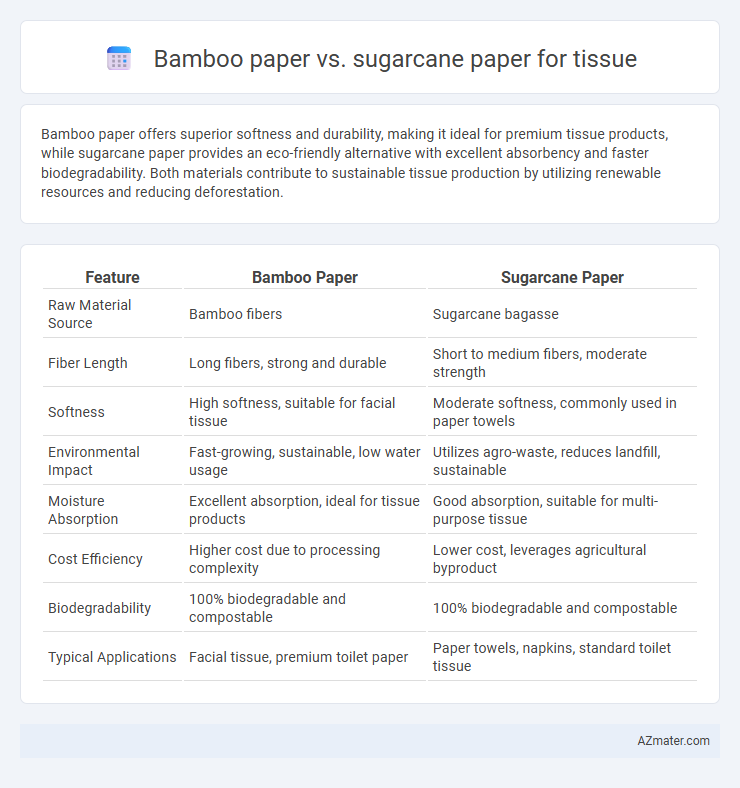Bamboo paper offers superior softness and durability, making it ideal for premium tissue products, while sugarcane paper provides an eco-friendly alternative with excellent absorbency and faster biodegradability. Both materials contribute to sustainable tissue production by utilizing renewable resources and reducing deforestation.
Table of Comparison
| Feature | Bamboo Paper | Sugarcane Paper |
|---|---|---|
| Raw Material Source | Bamboo fibers | Sugarcane bagasse |
| Fiber Length | Long fibers, strong and durable | Short to medium fibers, moderate strength |
| Softness | High softness, suitable for facial tissue | Moderate softness, commonly used in paper towels |
| Environmental Impact | Fast-growing, sustainable, low water usage | Utilizes agro-waste, reduces landfill, sustainable |
| Moisture Absorption | Excellent absorption, ideal for tissue products | Good absorption, suitable for multi-purpose tissue |
| Cost Efficiency | Higher cost due to processing complexity | Lower cost, leverages agricultural byproduct |
| Biodegradability | 100% biodegradable and compostable | 100% biodegradable and compostable |
| Typical Applications | Facial tissue, premium toilet paper | Paper towels, napkins, standard toilet tissue |
Introduction: Bamboo vs Sugarcane Tissue Paper
Bamboo tissue paper is renowned for its rapid renewability and strong fiber composition, providing softness and durability ideal for sensitive skin. Sugarcane paper, derived from agricultural waste, emphasizes sustainability by repurposing bagasse, delivering an eco-friendly alternative with comparable absorbency and strength. Both materials offer biodegradable options that reduce reliance on traditional wood pulp, advancing green practices in tissue production.
Raw Material Sourcing and Sustainability
Bamboo paper for tissue uses fast-growing bamboo that requires minimal water and no pesticides, making it highly sustainable and renewable compared to traditional wood pulp. Sugarcane paper derives from bagasse, a byproduct of sugar extraction, effectively utilizing agricultural waste and reducing landfill impact. Both raw materials support eco-friendly production, but bamboo's rapid renewability and sugarcane's circular resource use offer distinct sustainability advantages in tissue manufacturing.
Production Processes Compared
Bamboo paper production involves harvesting fast-growing bamboo stalks, which are mechanically and chemically processed to extract cellulose fibers, resulting in high tensile strength and natural antibacterial properties. Sugarcane paper, often made from bagasse--the fibrous residue left after juice extraction--undergoes pulping and bleaching processes similar to traditional wood paper production, emphasizing waste valorization and reduced deforestation impact. Both methods prioritize sustainability, but bamboo's rapid renewability contrasts with sugarcane's alignment with agro-industrial byproduct utilization in tissue manufacturing.
Environmental Impact and Carbon Footprint
Bamboo paper for tissue production offers a significantly lower environmental impact due to the plant's rapid growth rate and minimal need for pesticides, resulting in reduced deforestation and biodiversity loss compared to traditional wood pulp sources. Sugarcane paper utilizes bagasse, a byproduct of sugar extraction, which enhances waste valorization and decreases landfill contributions, while requiring less water and energy in its manufacturing process, thereby lowering overall carbon emissions. Both alternatives exhibit substantial carbon footprint reductions relative to conventional wood-based tissue papers, but bamboo's high yield per hectare and renewable characteristics generally provide superior sustainability benefits.
Strength, Softness, and Absorbency: Performance Analysis
Bamboo paper offers superior strength due to its long, durable fibers, making it highly resilient for tissue applications without compromising softness. Sugarcane paper excels in softness and absorbency, attributed to its fine fiber structure that allows quick liquid absorption and a gentle texture. Analyzing performance, bamboo paper provides enhanced durability, while sugarcane paper delivers premium softness and efficient moisture retention, making both materials suitable depending on tissue product requirements.
Biodegradability and Compostability
Bamboo paper for tissue products exhibits high biodegradability due to its natural cellulose fibers, breaking down efficiently within weeks under composting conditions. Sugarcane paper also demonstrates excellent compostability, benefiting from residual bagasse fibers that decompose rapidly without leaving harmful residues. Both materials serve as eco-friendly alternatives to traditional wood-based tissue, promoting sustainable waste management through faster degradation and nutrient recycling in soil.
Water and Energy Usage in Manufacturing
Bamboo paper manufacturing uses significantly less water compared to sugarcane paper, consuming approximately 150 liters per kilogram versus sugarcane's 800 liters per kilogram, reducing environmental strain. Energy consumption in bamboo paper production is also lower due to its fast-growing nature and efficient fiber extraction processes, leading to about 30% energy savings. These factors make bamboo paper a more sustainable choice in tissue production, minimizing resource depletion and carbon footprint.
Cost Efficiency and Market Price
Bamboo paper for tissue manufacturing offers higher cost efficiency due to faster growth cycles and lower water consumption, resulting in reduced raw material expenses compared to sugarcane paper. Sugarcane paper, derived mainly from bagasse, can be less expensive in regions with abundant sugarcane waste but often requires more intensive processing, impacting overall market price. Market prices for bamboo tissue generally reflect premium pricing driven by sustainability and durability benefits, while sugarcane tissue competes more aggressively on price due to its abundant feedstock availability.
Consumer Perceptions and Preferences
Consumers often perceive bamboo paper as more sustainable and eco-friendly compared to sugarcane paper, associating bamboo's rapid growth cycle with better environmental impact. Preference trends show a higher demand for bamboo paper tissues in markets prioritizing biodegradability and carbon footprint reduction, while sugarcane paper is favored for its softness and affordability. Market surveys indicate that consumers increasingly seek transparency in sourcing, with bamboo tissue products benefiting from stronger green marketing appeals.
Conclusion: Choosing the Right Eco-Friendly Tissue
Bamboo paper offers superior sustainability with rapid growth cycles and high biodegradability compared to sugarcane paper, which relies on agricultural byproducts and has a lower carbon footprint. For tissue products, bamboo paper provides enhanced softness and strength, making it ideal for consumer comfort and durability. Selecting eco-friendly tissue depends on balancing environmental impact with performance needs, where bamboo paper generally leads in renewability and tissue quality.

Infographic: Bamboo paper vs Sugarcane paper for Tissue
 azmater.com
azmater.com